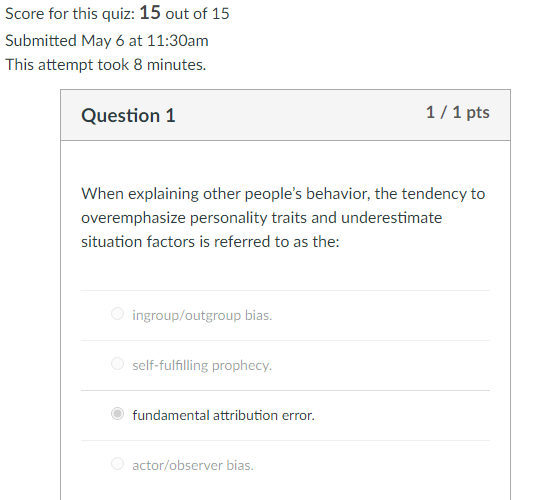Quiz #11 Social Psychology-PSYC-101
Quiz #11 Social Psychology-
Question 1
When explaining other people’s behavior, the tendency to overemphasize personality traits and underestimate situation factors is referred to as the:
ingroup/outgroup bias.
self-fulfilling prophecy.
fundamental attribution error.
actor/observer bias.
Question 2
Researchers have found that Native Americans tend to ________ eye contact when interacting with the elderly because looking at their eyes conveys ________.
avoid; disrespect
seek; respect
seek; respect
avoid; inferiority
seek; truthfulness
Question 3
According to the elaboration likelihood model, persuasion occurs through the ________ routes.
implicit and explicit
emotional and rational
emotional and rational
dissonant and consonant
central and peripheral
Question 4
John and Nolan are huge fans of the New York Knicks basketball team, whereas Brad is a fan of the Brooklyn Nets. Which of the following is John most likely to do?He will favor Nolan because Nolan belongs to the ingroup.
He will be hostile to Brad because of discrimination.
He will favor Brad because Brad belongs to the outgroup.
He will like Nolan and Brad equally because of stereotypes.
Question 5
Behaving in a way that confirms your own or other people’s expectations is referred to as:
stereotyping.
discrimination.
prejudice.
a self-fulfilling prophecy.
Question 6
Which of the following questions would NOT be investigated in social psychology?
Why do fraternities use hazing on new members?
Why does the quality of episodic memory degrade over time?
Why do people change attitudes when they realize their behavior is not in line with their beliefs?
Why does advertising work?
Question 7
Brent blames his poor performance in a recent marathon race on his poorly fitting shoes instead of on him being a slower runner. Brent’s reasoning illustrates the:
fundamental attribution error.
actor/observer bias.
actor/observer bias.
ingroup/outgroup bias.
self-fulfilling prophecy.
Margo is a new college student. According to research on interpersonal attraction, with whom is Margo most likely to become friends?
Mike, the boy in her lab who she sees once a week
Mitch, the boy in her class who she sees on Mondays and Wednesdays
Matt, the boy who lives down the hall who she sees every day
Marvin, the boy in her hometown, who she sees during winter vacation
Question 9
Elena is working on a team project for her computer science class. Although the entire team is responsible for the project, some people do not feel personally responsible for contributing to it. Because of this, some team members do not complete their assigned tasks. This is most likely due to:
group polarization.
social facilitation.
social facilitation.
social loafing.
groupthink.
Question 10
Miriam believes she is not attractive, so she typically wears ugly clothing. As a result, men rarely show interest in her, which confirms to her that she is not attractive. Miriam’s behavior is an example of a(n): ingroup/outgroup bias.
fundamental attribution error.
actor/observer bias.
self-fulfilling prophecy.
Question 11
Franklin sees that Sarah often goes to her math professor’s office hours. Franklin thinks that Sarah must be terrible at math. This is an example of the:
fundamental attribution error.
ingroup/outgroup bias.
ingroup/outgroup bias.
actor/observer bias.
self-fulfilling prophecy.
Question 12
Cassie is going to join a gym because new membership is very cheap. When she gets there, she discovers that there are added costs for towels, classes, and lockers. Although the final price is much higher than she originally believed, she still signs up. The gym has just used the ________ strategy to get Cassie to buy a membership.
normative influence
lowballing
lowballing
foot-in-the-door
door-in-the-face
Question 13
Flora’s car breaks down, leaving her stranded on the highway in the middle of rush hour. As more and more cars drive past her, Flora is surprised that no one stops to help her. The fact that other drivers fail to help Flora is most likely explained by:
reciprocal helping.
group polarization.
group polarization.
deindividuation.
the bystander intervention effect.
Question 14
Two women, Jackie and Roberta, ask Katie out. Although she likes both of them, Katie decides to go out with Jackie. Afterward, she starts to notice more positive qualities about Jackie and more negative qualities about Roberta. Katie’s new attitude is most likely a result of
postdecisional dissonance.
cognitive dissonance.
justification of effort.
attitude accessibility.
Question 15
You are trying to decide which of two horses in a race to bet on. After you make your decision, you are likely to be ________ sure about the horse you bet on because of ________.
more; cognitive dissonance
less; postdecisional dissonance
less; postdecisional dissonance
less; cognitive dissonance
more; postdecisional dissonance
Answer Preview-Quiz #11 Social Psychology-PSYC-101

$3.00
